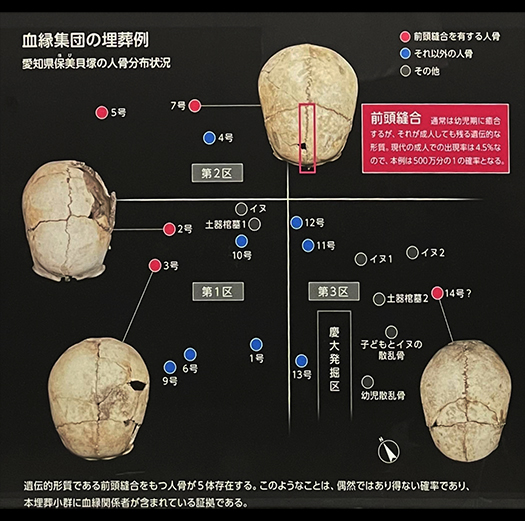


人類というのはごく初期から「一夫一婦」制だったという説が強い。
分子古生物学者・更科功氏「人類は一夫一婦制に向いていないのか」より
以下はその要旨。
〜環境の乾燥化によって森林が縮小した。そのためある類人猿グループは、
木がまばらにしか生えていない疎林に住まざるを得なくなった。
疎林には食料が少ないので食料を探すため広い範囲を歩き回らなくてはならない。
それはとくに子育てをしているメスにとっては大問題だ。
食料が子の分まで必要なのに子連れでは食料を探し回ることが難しいからだ。
しかし、もしメスや子に(専用に)食料を運んでくれるオスがいれば、
この問題は解決する。子はちゃんと食事ができてすくすくと育つだろう。・・・
一夫一婦制であればどれが自分の子かオスにすぐにわかる。
自分の子に食料を運んでこれるので、他人の子より自分の子がすくすくと育つ。
育った子は自分に似ているので、メスや子に食料を運ぶオスに育つ可能性が高い。
こうして一夫一婦制の場合は食料を運ぶオスが進化することになる。
直立二足歩行をすれば、手でものを運ぶのに便利だろう。一夫一婦制になれば、
オス同士の争いが減るので犬歯が小さくなる。ヒトには発情期がないので
交尾できるメスとオスの数がほぼ同じになり、やはりオス同士の争いが減る。
こういう状況証拠がいくつもあって類人猿から分かれて人類が進化した理由を
説明する説として現在もっとも有力な説となっている。〜引用終わり。
人類史ではこの説が主流となっていることを知ってから、
「家と人間」というわたしのライフワークテーマに強いインパクト。
巨視的な視点からも「家と家族」というポイントに集中できた。
というか、人類進化と家づくりが直接結びつくことに深く気付かされた。
今回の国立歴史民俗博物館展示の大変革で先史、旧石器・縄文期が
最近の研究成果を反映して大いに充実したなかで、このテーマについても
興味深い展示構成が発見された。それが上の展示パネル群。
墓というのは死後の世界の住み処とも言えるだろうけれど、
とくに3番目のパネル展示では特定の遺伝傾向「前頭縫合」に着目して
特定の墓域での出現確率が500万分の1であることを証していた。
「同一の家系による墓域」と科学的・確率論的に証明されたというのだ。
現代人も死後にも家という概念を永続する墓制を取っている。
まことに科学研究の進歩は喜ばしい。
家族という概念は人類が進化していく最初期からのものであり、
それがあってはじめて進化があり得たと見なせることがら。
その場としての住宅には気付かないような文化痕跡が残っているのだろう。
家を見つめながら人間を見つめるということの原点について
こういう縄文のひとびととも対話が可能になっていく。
English version⬇
Human History “Monogamy and Family/Home” 37,000 Years of Japanese Archipelago – 21
Monogamy as a choice of monogamy from the beginning of human history, which is now known to the public. The family form of the Jomon period as seen in the tombs. Family and Home
It is strongly believed that human beings have been monogamous from the very beginning.
Isao Sarashina, molecular paleontologist Is humanity unfit for monogamy
The following is a summary.
~The aridification of the environment has led to the shrinkage of forests. As a result, a group of apes were forced to live in sparse forests with only a few trees.
have been forced to live in sparsely forested areas where trees grow only sparsely.
Because food is scarce in sparse forests, they have to roam large areas in search of food.
This is a big problem, especially for females raising their young.
It is difficult for a female to search for food with her young when she needs food for her offspring as well.
However, if there is a male who can bring food (exclusively) to the female and her young
This problem is solved. The cubs would be well fed and grow up nicely. …
If monogamy is used, the male will know immediately which of his offspring is his.
Since he can bring food to his own offspring, his own offspring will grow up better than the offspring of others.
Since his own offspring will resemble him, they are more likely to grow up to be males that will bring food to the females and their offspring.
Thus, in the case of monogamy, a male carrying food will evolve.
If they walk upright and bipedal, it would be convenient for them to carry things by hand. Monogamy would
There would be less fighting between males, so the canines would be smaller. Since humans do not have a mating season
The number of females and males that can mate would be about the same, which would also reduce the number of male-male conflicts.
This circumstantial evidence is currently the most promising theory to explain why humans evolved from apes.
This is currently the most popular theory to explain why humans evolved by splitting off from apes. 〜End of quote.
After learning that this theory has become the dominant theory in human history
I have been strongly influenced by this theory in my life’s work, “House and Human Beings”.
From a macroscopic point of view, I was able to concentrate on the point of “home and family.
Or rather, I was deeply aware of the direct connection between human evolution and house building.
The prehistory, Paleolithic and Jomon periods in the National Museum of Japanese History exhibition underwent a major transformation this time.
The National Museum of Japanese History has been greatly enriched by the recent research results on prehistory, Paleolithic and Jomon period.
An interesting exhibition structure was found on this theme. The above panels are the most interesting ones.
The third panel in particular shows the tombs of certain geneticists.
The third panel in particular focuses on a specific genetic tendency
The third panel in particular focused on a particular genetic tendency and showed that the probability of its occurrence in a particular grave site was 1 in 5 million.
It was scientifically and probabilistically proven that the graves were of the same family lineage.
Modern humans also have a grave system that perpetuates the concept of family even after death.
This is truly a welcome advancement in scientific research.
The concept of family has existed since the beginning of human evolution.
It is only with the family that we can see that evolution was possible.
The house, as a place to live, probably retains traces of culture that we do not notice.
I would like to discuss the starting point of looking at people while looking at their homes.
It will be possible to have a dialogue with these Jomon people.
Posted on 11月 21st, 2022 by 三木 奎吾
Filed under: 日本社会・文化研究, 歴史探訪







コメントを投稿
「※誹謗中傷や、悪意のある書き込み、営利目的などのコメントを防ぐために、投稿された全てのコメントは一時的に保留されますのでご了承ください。」
You must be logged in to post a comment.